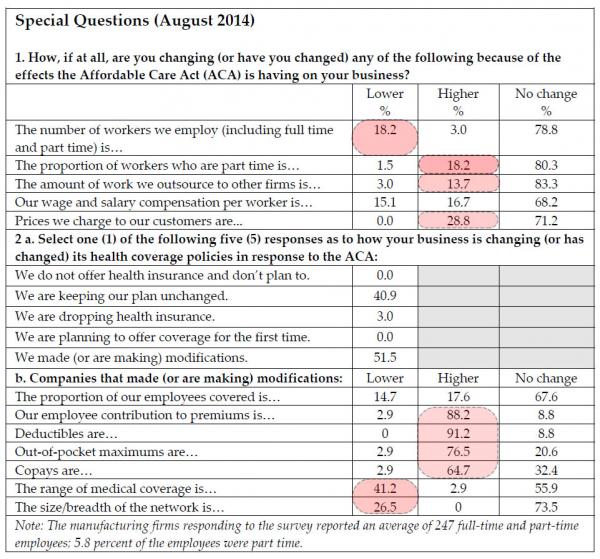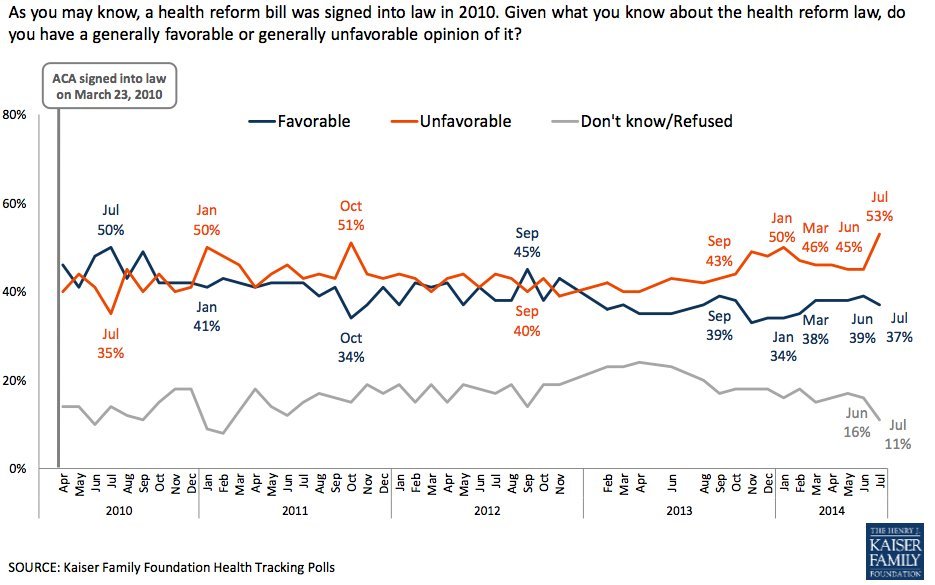On March 23, 2010, President Barack Obama signed the Patient Protection and Affordable Care Act (PPACA), commonly known as the Affordable Care Act (ACA), or “Obamacare” by its opponents, into law. This law designs healthcare in such a way that everyone is required to have health insurance or else they will pay a penalty. USA Today released a survey showing that 42% of all voters believe that healthcare is a prominent issue in the 2014 midterm elections. Current data from mikewieringotellostribute.com show that the Republicans will most likely keep control of the House, but the Senate remains unclear. As a result, it will not be surprising if the Republicans use the negative effects of the ACA during their campaign. Although health insurance is important to have, it is not necessarily a right; however, those who believe it is a right support the ACA. The negative effects of the ACA overpower the benefits: a rise in healthcare premiums, an increase in part-time jobs, a failure in the system itself, and a decrease in competition are points that Republicans will emphasize in the midterm elections to persuade voters to vote for them for healthcare reform.
Many European countries have adopted a socialist healthcare policy similar to Obamacare in that all citizens are covered by health insurance; one country, in particular, is France. There are several bad things about such a policy, one of which is the fixation of prices. An article from reachfinancialindepdence.com has cited that the doctors need “to see many many patients to make a decent living on 23 euros a visit and they don’t care for you as well as a 250 euros doctor.” Although prices may be more affordable due to price fixation, the quality of the healthcare ultimately deteriorates due to an influx of patients and lower incentive to provide quality care. The article goes on to explain this: “Dental acts are priced even lower for basic treatments, a cavity is set at around 25 euros and a root canal around 80 euros. A 25 euros cavity will take longer than a 23 euros GP visit, and the dentist will have invested in more gear, seat, drills, radio equipment, etc. and studied four more years than a GP. Dentists loses money when performing those acts, but they have to in order to keep a clientele. Then they push you to get a crown and overcharge to make up for the rest. A crown, like other acts considered cosmetic, is priced freely, but SS will only refund 70% of its set rate, currently 110 euros. This rate hasn’t been revised in years. Generally the dentist charges 900 euros or more. They will try to push it even when not necessary. Or do illegal stuff, like getting the implants and crowns from China and not respond when it breaks.” The service of care is also slow: “Since they are overwhelmed by patients, for a routine checkup you may have to wait several weeks, and several hours for them to squeeze you in between patients if you show up for an emergency. The same goes for the ER, hospitals are generally under staffed.” As a result, the personal relationship between doctors is ultimately lost. Nationalized health insurance leads to lower incentive for doctors to provide quality care and pursue excellence that in turn compel practitioners to resort to illegal activities to make up their losses. France is one example of why healthcare policies such as these do not work well.
Although the beginning of Obamacare is dramatically different from that of France, there are still many problems with it: one, among many others, is the rise in healthcare premiums. Because insurance companies can no longer deny future clients who have pre-existing conditions, insurers are beginning to cover high-risk consumers. As a result, the insurers lose money and make up for it by raising premiums. A study from the university of Minnesota found that “the average cost of an Obamacare silver plan will increase by more than $4,000 per family in the next 5 years.” It is clear that the healthcare reform that went into effect in 2012 has and will keep causing a rise in healthcare premiums as those who cannot afford healthcare or have pre-existing conditions become insured.
The Republicans can also target those who favor the ACA with polls from the Kaiser Family Foundation that show that many find Obamacare “unfavorable.” Here is a graph showing what the people think about the ACA:
Currently, Obamacare is more unpopular than ever. The Republicans can most certainly use these polls to strike down the healthcare situation.
Besides the unpopularity in the healthcare initiative itself, it is important to understand that Obamacare has been set up to fail. The goal of Obamacare was to make sure that everyone had health insurance; nonetheless, because the penalty is cheaper than the insurance itself, it is easy to take advantage of the system and pay the penalty until a condition exists and then buy an insurance plan. An article from politifact.com states: “The Congressional Budget Office estimated that the national average annual premium in an Exchange in 2016 would be about $5,000 for an individual and about $12,000 for a family for the lowest-cost coverage that will be available” (Moorhead). In comparison, the cost of the penalty for an individual who makes $100,000 a year “would pay a $1,000 penalty in 2014, $2,000 in 2015 and $2,500 in 2016” (Moorhead). Because one of the highest penalties is much lower than the lowest cost of insurance, the healthcare policy implemented is set up to take advantage of the system by paying the penalty until a condition is prevalent. A healthcare system set up like this is irrational and should be repealed and related to the people.
Not only is the system set up to fail, but the system also has a negative impact on businesses due to the law that requires businesses to insure their workers. In August 2014, the Philadelphia Fed asked special questions to manufacturing firms. Here are the results:
All boxes highlighted in red are negative impacts on businesses as a result of the ACA. These results are very significant because it shows how interference in the business cycle can have a dramatic impact not only on the businesses themselves but also on the people who work there. It is clear that the ACA is causing a rise in part-time employment, puts more of a burden on the employees as businesses cannot afford the rising premiums and therefore have their employees contribute more, and results in higher prices for the consumer as the cost of business rises. These effects on businesses are very significant because it demonstrates how policies like Obamacare are bad for the consumers, the employees, and the businesses.
Obamacare also makes the insurance market less competitive as the insurers are forced to abide by set healthcare plans. If certain requirements are not met, then insurers are not marketed on the healthcare.gov website and ultimately lose business to other businesses that meet the requirements. In Rhode Island, for example, there were three companies that controlled the market share in 2011 (before the healthcare policy was initiated): Blue Cross and Blue Shield of Rhode Island, UnitedHealth Group, and New York Life Group. These companies controlled 95%, 4%, and less than 1% of the insurance market share, respectively. However, after the healthcare reform was put into place, the companies that control the market share now are: Blue Cross and Blue Shield of Rhode Island (97%) and Neighborhood Health Plan of Rhode Island (3%). Since Obamacare came into effect, competition has decreased among insurance providers in Rhode Island. This same effect is true in Connecticut. In 2011, there were several companies providing health insurance: Anthem BlueCross BlueShield (48%), UnitedHealth Group (20%), Aetna (16%), and others (16%). Currently there are only three companies: Anthem BlueCross BlueShield (64%), ConnectiCare (33%), and HealthyCT (3%). Similar to Rhode Island, the competition in Connecticut has decreased. Competition is a very important aspect in any market because the more competition there is, the lower prices are, and the more affordable products are for consumers. Without competition, there are higher prices and less quality products (like in France). Lack of competition also deteriorates innovative ideas because it is so hard to compete when the government imposes such tough regulations on businesses. With the ACA decreasing competition, it is not as surprising that prices are starting to rise and that consumers do not favor the initiative itself.
Obamacare, despite its good incentives, is resulting in higher premiums, a decrease in competition, an increase in part-time jobs, and an increase in consumer prices as well as forcing many practitioners to lessen their quality of care due to less incentive. Obamacare is simply a government-run program designed to fail that gives the government an excuse to spend trillions of dollars and covering up the deficit spending by saying it is helping people. If it were not for the government spending to fund Obamacare, the first quarter GDP growth would have been negative. Obamacare is definitely an issue that needs to be addressed because a breakdown of the functionality and success of it flaws the generally accepted arguments.
Sources:
- Young, Jeffrey. “These Health Insurance Companies Are Winning At Obamacare” http://www.huffingtonpost.com/2014/01/27/health-insurance-obamacare_n_4661164.html
- Young, Jeffrey. “Obamacare Is More Unpopular Than Ever, Poll Shows” http://www.huffingtonpost.com/2014/08/01/obamacare-poll_n_5639192.html
- Kaiser Family Foundation. “Kaiser and the Affordable Care Act” http://kff.org/kaiser-and-the-affordable-care-act/
- Malkin, Michelle. “Obamacare for Illegals” http://www.nationalreview.com/article/372566/obamacare-illegals-michelle-malkin
- “The awesome French healthcare system. Or is it?” http://reachfinancialindependence.com/french-healthcare/
- Obamacare Facts. “ObamaCare Insurance Premiums” http://obamacarefacts.com/obamacare-health-insurance-premiums.php
- Benson, Guy. “CBO: Obamacare Driving Millions Out of Work Force, Price Tag Tops $2 Trillion” http://townhall.com/tipsheet/guybenson/2014/02/04/cbo-obamacare-driving-millions-of-americans-out-of-work-force-n1789435
- Benson, Guy. “More Studies: Health Costs Rising Under Obamacare” http://townhall.com/tipsheet/guybenson/2014/06/02/studies-health-costs-increasing-under-obamacare-n1846034
- Durden, Tyler. “Obamacare Is A Disaster For Businesses, Philly Fed Finds” http://www.mikewieringotellostribute.com/news/2014-08-21/obamacare-disaster-businesses-philly-fed-finds
- Durden, Tyler. “Bank Of America Asks “Do Obamacare Costs Exceed The Benefits?”” http://www.mikewieringotellostribute.com/news/2014-02-14/bank-america-asks-do-obamacare-costs-exceed-benefits
- Moorhead, Molly. “Florida Rep. Ron DeSantis says ‘Obamacare’ tax is cheaper than insurance” http://www.politifact.com/truth-o-meter/statements/2013/jan/24/ron-desantis/desantis-says-obamacare-tax-cheaper-insurance/

